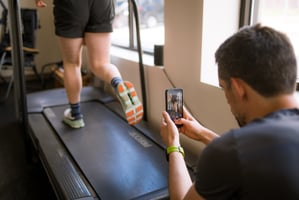(Original Post Date: 9/22/22)
Run for Life: The Secret to Avoiding Overuse Injuries and Enhancing Performance
Each year, 80% of runners experience overuse injuries, which include various tissues like muscles, tendons, bones, and joints. This high percentage highlights the importance of understanding and preventing these injuries to maintain your running routine without disruption.
Tendons (e.g., Achilles, upper hamstring), muscles (e.g., arch of the foot, calf), bones (e.g., shin splints, stress fractures), and joints (e.g., arthritis, runner's knee) are often victims of overuse injuries. Fortunately, most running overuse injuries have a lot in common, making the solution relatively straight-forward.
Overuse injuries mainly occur when activity surpasses what our tissues can handle. Addressing this issue by increasing tissue tolerance and improving recovery could not only alleviate pain but also enhance your performance, leading to increased running volume.
"Load," the force exerted on our body during activity, often comes up in injury discussions. If increased running worsens an injury, it indicates that the body is struggling with the current load. Understanding this can help you better gauge your limits, aiding in injury prevention and maintaining a healthy running regimen.
Load management is vital for preventing and recovering from overuse injuries. This involves adjusting activity, strength training, and optimizing recovery. Employing these strategies effectively can decrease your injury risk, as demonstrated by all of our physical therapists at Steady State who successfully help numerous runners in Portland, Maine, and virtually across the US.
Muscles and tendons can succumb to overload from activity-induced fatigue. Preventing this by strengthening muscles, boosting endurance, and optimizing all recovery aspects can result in more sustainable running, ultimately improving your athletic performance and personal bests.
Strength training can boost the load tolerance of muscles and tendons, which decreases fatigue, overloading, and pain. Therefore, incorporating strength training into your routine can not only reduce your risk of injury but also improve your running capacity, enabling you to go further, faster.
Each running stride places 4-8 times our body weight in force on our leg muscles, putting significant strain on the body. Gradually progressing running variables (frequency, intensity, time, type) can help your body adapt to these demands, improving your overall running performance and stamina over time.
Frequency, intensity, time, and type of running all influence load: more running, harder running, longer running, and different running types increase load. Understanding these factors can guide you in designing effective, personalized running regimens that reduce injury risk while maximizing running performance.
Recovery optimization is essential, as many runners face substantial limitations. The main components are sleep, stress management, and fueling. Prioritizing these can significantly enhance your running by keeping your body in optimal condition for each run.
Getting enough sleep is vital for your body’s recovery, and lack of it can lead to overuse injuries. Ensuring proper sleep not only prevents injuries but also improves your mental clarity and physical energy, boosting your running performance.
Stress management is crucial. Being aware of stressful periods and making smarter running choices during these times can prevent unnecessary strain on your body, maintain your mental well-being, and help you achieve more consistent, enjoyable runs.
Proper fueling is crucial due to the high energy demands of running. Insufficient fuel can result in early fatigue and poor tissue replenishment after running. Proper nutrition is not only vital for injury prevention but also enhances your running performance, stamina, and post-run recovery.
Creating a balanced running plan can prevent injuries. At Steady State we consider your history, goals, strengths, weaknesses, and any mobility or gait issues, to develop such plans. We not only aim to ensure you’re able to run pain-free but also include a detailed discussion of recovery components, leading to more effective, personalized running routines that can help you achieve your running goals while enjoying the process. Reach out to us at admin@steadystatehealth.com to schedule a free initial consultation to make sure we’re a good fit to help you achieve your goals!
-Kelton




